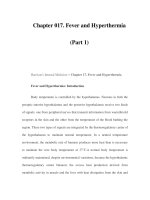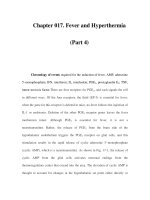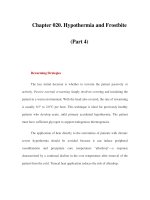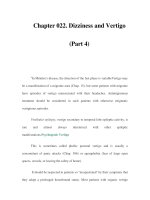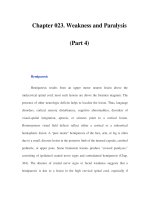Chapter 040. Diarrhea and Constipation (Part 4) docx
Bạn đang xem bản rút gọn của tài liệu. Xem và tải ngay bản đầy đủ của tài liệu tại đây (15.58 KB, 5 trang )
Chapter 040. Diarrhea and
Constipation
(Part 4)
Acute Diarrhea
More than 90% of cases of acute diarrhea are caused by infectious agents;
these cases are often accompanied by vomiting, fever, and abdominal pain. The
remaining 10% or so are caused by medications, toxic ingestions, ischemia, and
other conditions.
INFECTIOUS AGENTS
Most infectious diarrheas are acquired by fecal-oral transmission or, more
commonly, via ingestion of food or water contaminated with pathogens from
human or animal feces. In the immunocompetent person, the resident fecal
microflora, containing >500 taxonomically distinct species, are rarely the source
of diarrhea and may actually play a role in suppressing the growth of ingested
pathogens. Disturbances of flora by antibiotics can lead to diarrhea by reducing
the digestive function or by allowing the overgrowth of pathogens, such as
Clostridium difficile (Chap. 123). Acute infection or injury occurs when the
ingested agent overwhelms the host's mucosal immune and nonimmune (gastric
acid, digestive enzymes, mucus secretion, peristalsis, and suppressive resident
flora) defenses. Established clinical associations with specific enteropathogens
may offer diagnostic clues.
In the United States, five high-risk groups are recognized:
1. Travelers. Nearly 40% of tourists to endemic regions of Latin
America, Africa, and Asia develop so-called traveler's diarrhea, most
commonly due to enterotoxigenic or enteroaggregative Escherichia coli as
well as to Campylobacter, Shigella, Aeromonas, norovirus, Coronavirus
and Salmonella. Visitors to Russia (especially St. Petersburg) may have
increased risk of Giardia-associated diarrhea; visitors to Nepal may acquire
Cyclospora. Campers, backpackers, and swimmers in wilderness areas may
become infected with Giardia. Cruise ships may be affected by outbreaks
of gastroenteritis caused by agents such as Norwalk virus.
2. Consumers of certain foods. Diarrhea closely following food
consumption at a picnic, banquet, or restaurant may suggest infection with
Salmonella, Campylobacter, or Shigella from chicken; enterohemorrhagic
E. coli (O157:H7) from undercooked hamburger; Bacillus cereus from fried
rice; Staphylococcus aureus or Salmonella from mayonnaise or creams;
Salmonella from eggs; and Vibrio species, Salmonella, or acute hepatitis A
from seafood, especially if raw.
3. Immunodeficient persons. Individuals at risk for diarrhea
include those with either primary immunodeficiency (e.g., IgA deficiency,
common variable hypogammaglobulinemia, chronic granulomatous
disease) or the much more common secondary immunodeficiency states
(e.g., AIDS, senescence, pharmacologic suppression). Common enteric
pathogens often cause a more severe and protracted diarrheal illness, and,
particularly in persons with AIDS, opportunistic infections, such as by
Mycobacterium species, certain viruses (cytomegalovirus, adenovirus, and
herpes simplex), and protozoa (Cryptosporidium, Isospora belli,
Microsporida, and Blastocystis hominis) may also play a role (Chap. 182).
In patients with AIDS, agents transmitted venereally per rectum (e.g.,
Neisseria gonorrhoeae, Treponema pallidum, Chlamydia) may contribute
to proctocolitis. Persons with hemochromatosis are especially prone to
invasive, even fatal, enteric infections with Vibrio species and Yersinia
infections and should avoid raw fish.
4. Daycare attendees and their family members. Infections with
Shigella, Giardia, Cryptosporidium, rotavirus, and other agents are very
common and should be considered.
5. Institutionalized persons. Infectious diarrhea is one of the
most frequent categories of nosocomial infections in many hospitals and
long-term care facilities; the causes are a variety of microorganisms but
most commonly C. difficile.
The pathophysiology underlying acute diarrhea by infectious agents
produces specific clinical features that may also be helpful in diagnosis (Table 40-
2). Profuse watery diarrhea secondary to small bowel hypersecretion occurs with
ingestion of preformed bacterial toxins, enterotoxin-producing bacteria, and
enteroadherent pathogens. Diarrhea associated with marked vomiting and minimal
or no fever may occur abruptly within a few hours after ingestion of the former
two types; vomiting is usually less, and abdominal cramping or bloating is greater;
fever is higher with the latter. Cytotoxin-producing and invasive microorganisms
all cause high fever and abdominal pain. Invasive bacteria and Entamoeba
histolytica often cause bloody diarrhea (referred to as dysentery). Yersinia invades
the terminal ileal and proximal colon mucosa and may cause especially severe
abdominal pain with tenderness mimicking acute appendicitis.

